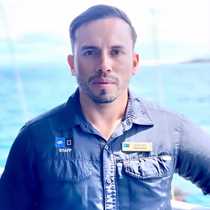We woke up and discovered that our ship had anchored right in the middle of an extinct volcano. We had arrived at Genovesa Island, the northernmost island we visited this week.
After breakfast, we had a wet landing in Darwin Bay, where we were welcomed by hundreds of seabirds, from great frigatebirds to brown pelicans and swallow-tailed gulls. But we were on the lookout for the one species we had yet to see on the other islands: the red-footed booby. We had come to the right spot. Genovesa is home to about 200,000 of them.
This was the time to enjoy the red-footed boobies. Many of their chicks had just hatched, and some already were covered with fuzziness to camouflage against predators. The adults were just coming back from fishing and frigatebirds were chasing them, trying to steal their food.
After walking along the mangroves covered with red-footed booby nests, we went snorkeling along the caldera of this old volcano, where we encountered many species of fish and some fur seals in the water.
During the afternoon, we hiked Prince Philip’s Steps with some “garua” welcoming us along the path. Although it was misty, we saw many birds in action. We were even luckier to spot several short-eared owls near the path. They were waiting for storm petrels to return to their nesting grounds, where the owls could prey on them.
We had a spectacular expedition around the Galápagos archipelago. Observing and interacting with endemic species and unique landscapes, we felt part of the ecosystem. We experienced the Galápagos at their most magical stage.



.jpg?width=106&height=85&mode=crop&scale=both&quality=50)


